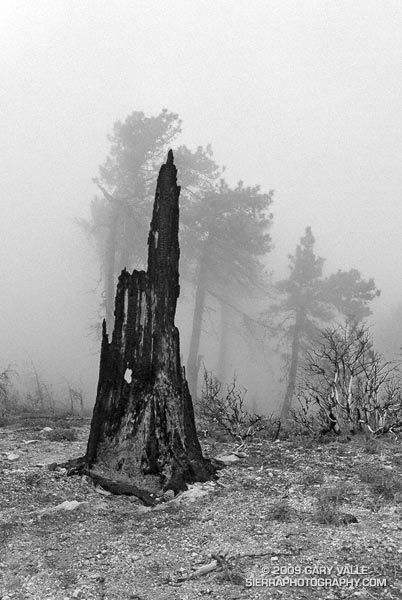
From Sunday’s hike/run up and down Mt. Baldy’s South Ridge.

From Sunday’s hike/run up and down Mt. Baldy’s South Ridge.
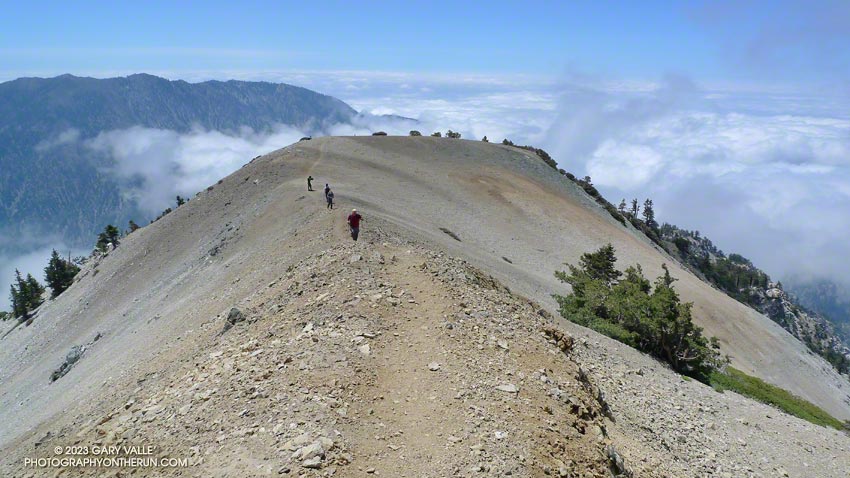
One, two, ten…
Will the switchbacks ever end?
I can’t think of a tougher stretch of trail in the San Gabriel Mountains. From Mt. Baldy Village, the Bear Canyon/Old Mt. Baldy Trail climbs 5800′ in 6.7 miles to the 10,064′ summit of Mt. Baldy (Mt. San Antonio). The route is as rewarding as it is difficult, with inspiring views and interesting terrain.
I had hoped for some remnant clouds from Friday’s storms, but didn’t expect to be using my windshield wipers driving to the trailhead. The dark gray clouds piled against the mountains had a scuddy, stormy look, and I had a difficult time convincing myself that it was just a deep marine layer. But the sun was shining when I parked at the bottom of Bear Canyon Rd. and began to walk up the steep, cabin-lined street.
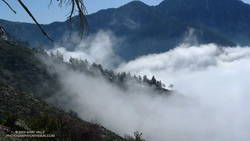
The last time I had been on the trail was July 2004, during the Baldy Peaks 50K. That day we started at the parking lot at Icehouse Canyon, and over the course of the race climbed Mt. Baldy twice. The first time from the Village, and the second time from Manker Flats. Today I wasn’t in a race, and would be completely satisfied to climb Mt. Baldy just once.
Running up a moderate section of trail below Bear Flat, I tried to figure out the last time I had run down the Bear Canyon Trail. Sometime before the Baldy Peaks race. I wasn’t sure how long it had been, but long enough to forget how grueling steep downhill can be.
My thoughts are interrupted by a pair of hikers coming down the trail. I ask how they’re doing, and am surprised to hear, “not so good.” They look disappointed and tired, and anxious to get down to the car. I wonder if one of them is ill, or if they just underestimated the difficulty of the trail.
A half-mile later I’m crossing the creek at Bear Flat (~5500′). This is where the fun begins. Here the trail switchbacks up a steep east-southeast facing chaparral slope to Mt. Baldy’s South Ridge, gaining about 1500′ in one mile. On a warm day it can be hellish. On a cool day it isn’t easy. Today it is cool. The cloud layer has continued to crawl up the mountain, and it envelops me as I start up the switchbacks.
A little more than a year ago, these slopes were burned in the 2008 Bighorn Fire. I had expected to see black, burned and barren chaparral in the initial stage of recovery, but instead there is substantial growth, comparable to 2-3 years of recovery in chaparral at a lower elevation.
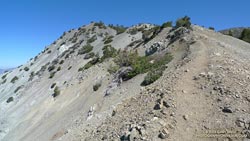
At an elevation of about 7000′, I climb out of the clouds and into the sun. What a day! Benign clouds lap at the mountainside, enhancing already dramatic views. Between 7000′ and 9000′, I encounter several hikers and briefly chat with one veteran hiker, who tells me this is his friend’s intro to hiking! It is a busy day for this trail, and I’m guessing I’ll see more hikers when I descend.
Above 9000′ the open forest of Jeffrey, Sugar and Lodgepole pine becomes more sparse and stunted. The route feels more alpine and climbs onto the rocky crest of an exposed ridge (HD Video Snapshot). A little higher, a large patch of snow accentuates the “you’re getting near tree line” feeling.
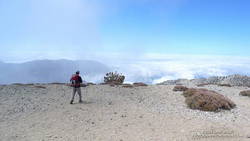
Approaching Baldy’s summit, I’m surprised to see a wispy cloud had also ascended the peak and is waiting for me to catch up. On top there seems to be a mix of young and old, veterans and first-timers, excitement and exhaustion. After a few minutes on the summit, I run over to West Baldy. Then it is gravity’s turn, and I take the first steps down the slope.
The descent is just as extraordinary as the ascent, with far-reaching mountain views over a sea of clouds. On an exposed section of the ridge at about the 8500′ I happen on a Sugar pine with a spiral scar from a lightning strike. Such trees are disturbingly common. There is a Jeffrey pine at about the same elevation on Mt. Baldy’s North Backbone Trail with a similar lightning scar.
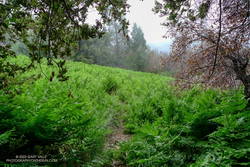
At around 7500′, I descend into the clouds. The change from blue to gray does not carry with it the usual malaise. Wisps of warm cloud thread softly through the pines and a solitary deer walks silently through the dream-like scene (Video snapshot).
One, two, ten… Will the switchbacks ever end? Finally, through the trees I see the brilliant green of the ferns at Bear Flat. Running becomes easier. I pick up the pace, and in a few minutes turn onto the asphalt of Bear Canyon road.
Here is an interactive, 3D terrain view of a GPS trace of my route on the Mt. Baldy’s South Ridge on the Bear Canyon/Old Mt. Baldy Trail. The map can be zoomed, tilted, rotated, and panned using the navigation control on the right. Track and placename locations are approximate and subject to errors. Snow, ice, poor weather, and other conditions may make this route unsuitable for this activity.
Some related posts: Mt. Baldy Runner, Lightning Tree
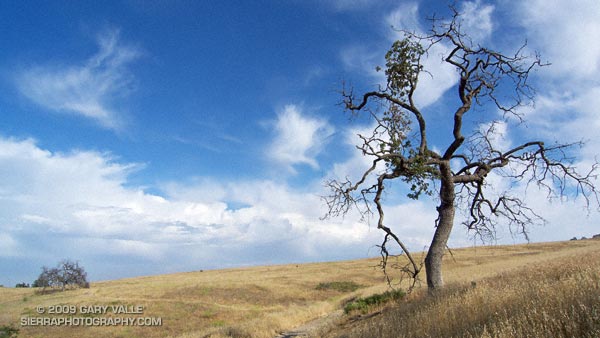
Off to the south, I heard the distant rumble of thunder. The developing line of thunderstorms had swept through the West Valley about an hour before I began my run at Ahmanson Ranch.
Unusual weather for June. Not so much that there were thunderstorms, but that the thunderstorms were in part the result of an unseasonably strong jet embedded in the base of an upper level low.
It’s a bit of a stretch, but an argument could be made that these storms were a calling card of an increasingly energetic atmosphere, and a developing El Niño.
Several factors point to an increased probability of El Niño conditions developing over the next few months. Among them, Equatorial Pacific SSTs have increased, and the subsurface heat content is the highest it’s been since the El Niño of 2006-07.
But as the short-lived 2006-07 El Niño event demonstrates, an El Niño is more than just warm Pacific equatorial SSTs. Through complex forcing and feedback mechanisms, the atmosphere and oceans have to cooperate on a global scale. Generally speaking the atmosphere speeds up when there is an El Niño, and slows down during a La Nina.
And it looks like the atmosphere may be speeding up. Orbits of the Global Wind Oscillation, a measure of atmospheric momentum, have been shifting upward, in the direction of more energetic values usually associated with an El Niño.
But an El Niño is not a done deal. The climate system is just leaning in that direction. As climate scientist Klaus Wolter has pointed out, in a similar situation in 1973-1975, the climate fell back into a La Niña for another year. At this point it appears we may be diverging from that analog case. We’ll see!
Update June 6, 2009. The April-May Multivariate ENSO Index (MEI) value, released today, has increased by 0.54 to +0.34. As discussed by MEI originator, Klaus Wolter, the 3-month rise of the MEI since January-February is the 4th highest on record for this time of year, exceeded only by the strong Niño of 1997. According to Dr. Wolter, if next month’s MEI rank is at least the same as this month (37th), “it would be unprecedented for it to drop below that high-neutral ENSO-phase range by the end of 2009, virtually excluding a return to La Niña, based on the MEI record since 1950.”
Related links: ENSO Diagnostic Discussion, ENSO Wrap-Up
Click image above to start slide show.
Update May 30, 2009. In a Draconian measure that could close over 200 of California’s State Parks, Gov. Schwarzenegger has proposed cutting the State Parks core funding in half begining July 1, and then would eliminate ALL core funding in a year. For more information see the California State Parks Foundation web site.
Update May 18, 2008. Gov. Schwarzenegger’s revised state budget, released May 14, rescinded the funding cuts that would have resulted in the closing of 48 California state parks. For now it appears these state parks will remain open.
Following is the original post from February 2, 2008:
What a fantastic morning! Taking advantage of a break in a series of Southern California rain storms, I was running on Fire Road #30 near the entrance of Topanga State Park. The sun had found its way through a broken layer of clouds, and bright patches of sunlight highlighted the rugged terrain. Down in a steep canyon on my left, wisps of steam wafted from the chaparral.
Following an “On your left!” a group of mountain bikers swept past. Working up the hill toward the Hub, good morning’s were exchanged with other runners, hikers and cyclists.
Many of us live and work in California because of its diverse open spaces, parks and wilderness areas. Incredibly, this popular urban park, along with Will Rogers State Historic Park, Santa Susana SHP, Los Encinos SHP, Mt. San Jacinto SP, and forty-four other California State Parks have been slated for closure in the fiscal year 2008-09 California state budget.
According to an article in the Los Angeles Times, the selection was made according to the dour formula of those parks “that had the fewest visitors, produced the least revenue and would be the easiest to close off to visitors.”
This formula necessarily targets less developed parks, such as Topanga State Park, ignoring those intrinsic values that make a park a park. The formula targets walk-in parks, and the hikers, cyclists, riders, and runners that simply enjoy the outdoor experience. The formula targets day use parks in urban areas that don’t need campgrounds or additional services. And, the formula targets those with less to spend on recreation.
So is this how we are to appraise the value of our public lands? Closing our state parks would be astonishingly short-sighted. Their varied trails, terrain, and habitats are accessible to millions, providing a therapeutic escape from the rigors of city life, and experiences and insights that can only be gained from the out of doors.
Today I was doing one of my favorite runs in Topanga State Park. It links several trails and visits several popular destinations in the park — the Hub, Parker Mesa Overlook, Trippet Ranch, Eagle Rock, and the Musch, Garapito and Bent Arrow Trails.
This two minute slide show is a compilation from a few such runs. It is a small selection of photographs from one set of trails, in just one state park.
For more information regarding Topanga State Park, see the Topanga Canyon Docents and California State Parks web sites.
Google search: $g(slide show), $g(California state budget), $g(California State Parks), $g(Topanga State Park)
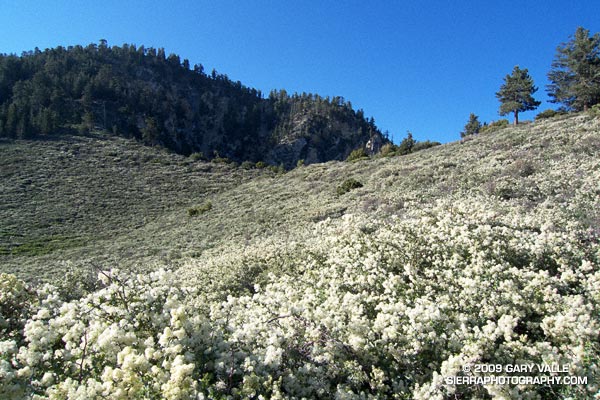
Snowbush on the Pacific Crest Trail near Islip Saddle
Below, the throaty rumble of an almost continuous stream of motorcycles echoes through the canyons. Closed by storm damage since the Winter of 2005, Highway 2 from Islip Saddle to Vincent Gap is open again.
It is also busy on the Pacific Crest Trail. I’m southbound on the PCT, and some of the hikers I’ve talked to are doing the route I’m doing — an out and back from Islip Saddle (6650′) to Mt. Baden-Powell (9,399′). At least one group has set up a car shuttle, and will descend to Vincent Gap after climbing Baden-Powell.
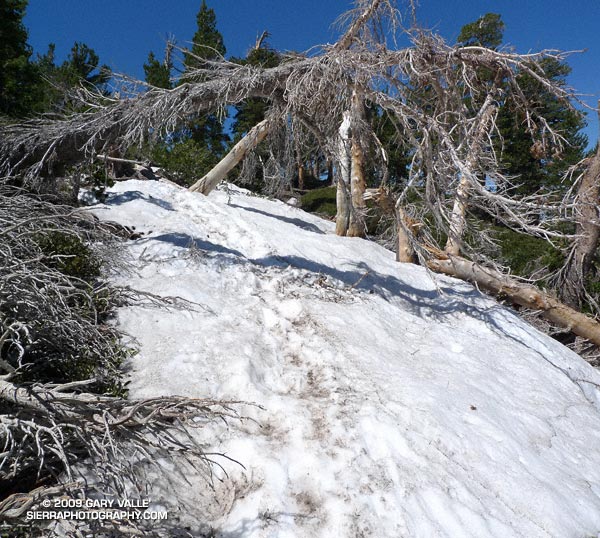
Northbound on the PCT, there has been a mix of youth groups returning to Islip Saddle after a night under the stars, and PCTers on their way to Canada. Nearly 400 miles into their 2650 mile trek, the PCTers look great, and if their broad smiles are any indication, they are enjoying life on the trail.
Whether hiking a couple of miles, or a couple thousand miles, it is great day to be outdoors. The weather is cool, and there is not a cloud in the sky. There are patches of snow here and there, and even some snow on the trail. My legs feel good, and I feel good.
Today I decided to keep things simple. Rather than climb Mt. Islip and other peaks along the way, I’m doing a basic out and back route to Baden-Powell. Even so, it’s no cakewalk. A quick calculation using the topo map gives an honest elevation gain/loss of at least 3600 ft.
Earlier, as I worked my way above Windy Gap, I was surprised to feel and then hear a distant, powerful, rumbling ka-boom! It wasn’t a motorcycle, or thunder — it was Space Shuttle Atlantis landing at Edwards!
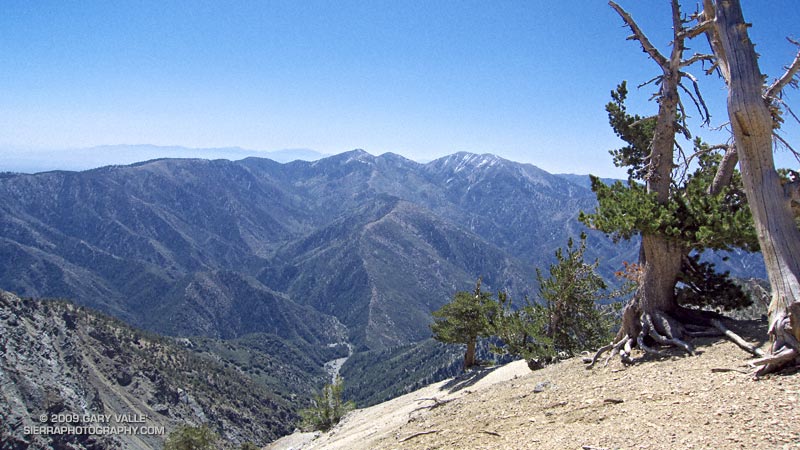
With a few stops, and a mix of hiking and running, it takes me about 2.5 hours to get to Baden-Powell. No one is on the summit. Across Vincent Gulch, Mt. Baldy (10,064′) looms in the haze. A few ribbons of snow embellish its north face.
I grab a Clif Bar from my pack, and walk along the ridge, looking at the weather worn trees. After a few minutes, I return to the summit and then descend to the Wally Waldron Tree. For an impulsive moment I briefly debate continuing down to Vincent Gap and doing the South Fork loop. It would “only” be about 7 miles longer, and I’d never done the loop counterclockwise… but instead I hang a left onto the PCT and take the first strides toward Islip Saddle. Maybe next time.
Here’s a Cesium browser View of a GPS trace of the approximately 16.5 mile route.
Some related posts: San Gabriels High Five, Snowless San Gabriels

So far, Brett’s intro to Bay Area trail running had taken me to the Marin Headlands and Pt. Reyes National Seashore — outstanding areas in which to run and hike, with great scenery, terrain and courses. An area that might be overlooked by a visiting trail runner is the Presidio. That’s where we were running this morning.
Warm weather had chased the fog away. Saturday, the high temp at SFO was 89 degrees, and today the high was forecast to be in the 90s. So it wasn’t a big surprise that at 7:30, the temp was already near 70 when we descended the stairs at Inspiration Point. (SFO would set a record high of 93 later in the day.)
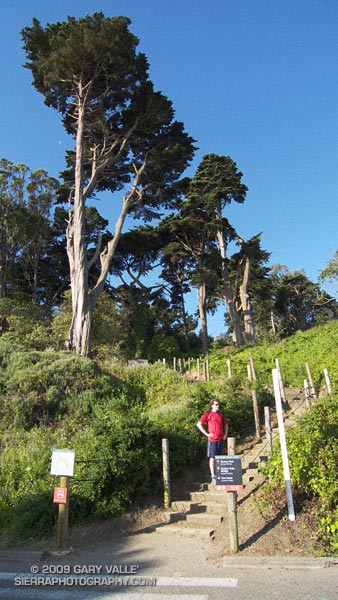
Our loop started on the Ecology Trail and then worked down through the Main Post, under the 101, across Crissy Marsh, and onto the Golden Gate Promenade (Bay Trail). From the Promenade there were iconic views of San Francisco Bay, Alcatraz, Marin, and the Golden Gate Bridge. Just past the Warming Hut we turned up the East Battery Trail stairs, and then continued west, under the southern abutments of the bridge.
Here we followed the Coastal Trail past several 100+ year old defense batteries, to another nice overlook of the Golden Gate. After clambering up on one of the battlements, we headed east to Fort Scott and picked up the Bay Area Ridge Trail. This segment took us through the Presidio’s trademark pine, cypress and eucalyptus forest to the high point of the course near Rob Hill Campground, then along the Presidio Golf Course, and finally down past Andy Goldsworthy’s cypress spire to the car. From the point of view of this out-of-towner, the course was spectacular, and it’s hard to imagine an urban run with more variety!
Our particular loop worked out to about 5.5 miles, with an elevation gain/loss of about 450 ft. Here’s a Presidio Trust map of Presidio Trails and Overlooks (PDF), a NPS Presidio Map, and a Cesium browser View of a GPS trace of our loop.
I had a great time in San Francisco, and can’t wait to get back and see more… Thanks Brett & Amanda!